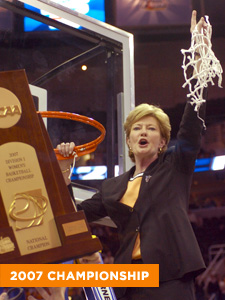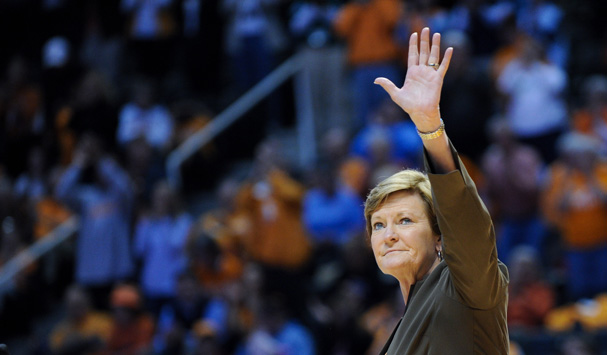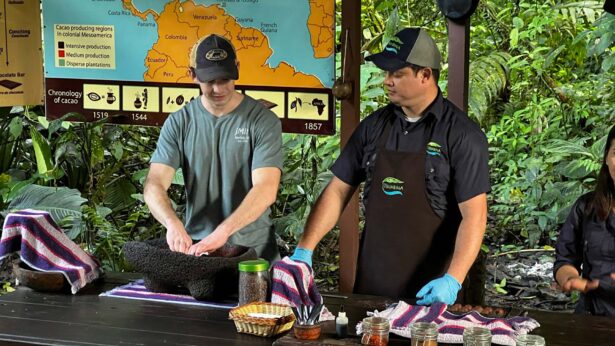Pat Summitt died on Tuesday, June 28 in Knoxville, Tenn. This feature story was published shortly after Summitt’s retirement in 2012
By Sally Jenkins
If you want to humble yourself, take on Pat Summitt in a brainteaser. The word-finders and the Sudoku are bad enough, but worst of all is a Shanghai tile game, a torturous affair that feels like a combination of mahjong and an eyesight test and leaves your scalp thrumming. Still, the headache isn’t the worst part. It’s her attitude.
“Are you ready to play?” you ask.
“Well, I don’t know,” she says, with a deceptive pleasantness. “Are you ready to get beat?”
It’s her matter-of-fact tone, you see, and the pursed, suppressed smile followed by the batted blue eyes hiding a gleam of pure triumph. All of a sudden you understand how the Connecticut rivalry got so heated.
Everyone wants to know how Pat is doing. How is she doing with the Alzheimer’s disease diagnosis, and how is she adapting to her new role as head coach emeritus? Here is how she’s doing: She remains the most cheerfully infuriating competitor you ever met. Let’s put it this way. Who but Pat would fight a memory-wasting disease by writing a memoir?
Who but Pat would fight a memory-wasting disease by writing a memoir? The idea is so like her – all elegance and swagger and undefeatedness.The idea is so like her – all elegance and swagger and undefeatedness. Last spring, when she announced that she was stepping aside as the head coach of the Lady Vols after 38 years, she termed it a “retirement with a small r.” It turns out there is nothing retiring about her. In the weeks after her decision, she launched her book project; collected the Medal of Freedom from President Barack Obama in Washington alongside Bob Dylan, whom she patted on the knee like a nice boy; made a hole in one on the golf course; accepted an appointment from Secretary of State Hillary Rodham Clinton to serve on a newly formed Council to Empower Woman and Girls Through Sports; worked her summer basketball camp; and helped her successor Holly Warlick form a new staff, on which she will continue to serve as an advisor and mentor. As Warlick says, “We’re going to use her in every way we can.”
Yours truly is her ghostwriter on the book project, reprising a role from 1997 when we collaborated on her bestseller Reach for the Summitt, followed by Raise the Roof. Back then, she was in the midst of an unprecedented three-peat run of national championships, while also raising her small son, renovating her house and co-chairing a United Way campaign. If you listen to the interview tapes, you can hear the sound of huffing. It’s me, trying to keep up.
Pat has always been preternaturally energetic. She remembers baling hay and pumping gas when she was 9 years old back on the family farm in Henrietta, Tenn. As a first-year head coach at Tennessee in 1974, she not only worked full time building her program, she also took four classes toward her master’s degree while teaching four more classes, including one, aptly, in self-defense. She was so principled in the classroom and so intolerant of laziness that she refused to dole out easy grades to the campus hero-athletes like Ernie Grunfeld, who signed up for her “Fundamentals of Basketball” course and then proceeded to cut it, thinking she would rubber stamp his transcript because he was a star on the men’s team.
 She gave him a D.
She gave him a D.
“How could you give me a D?” he asked incredulously.
“You didn’t show up,” she said.
“Yeah, but I know all that stuff,” he said.
“Ernie, get out of here,” she said, “before I give you an F.”
In between those obligations, she also handled the scheduling for five other women’s sports; trained for the 1976 Olympic women’s basketball team, which she would captain to a silver medal; taped ankles; drove the team van; washed the uniforms; and helped the janitor set up the folding chairs in Tennessee’s old Alumni Gym. It was a ramshackle little place that was so dark she said she needed a miner’s lamp to see the lines on the floor. At the beginning, there were crowds of just 50 or 100 spectators watching an overworked young woman trying to build a better life for herself and her players. The goal wasn’t a future dynasty. “It was to survive a year,” she said.
But all that energy led to something remarkable. In her second season, the crowds grew to 1,500, and by her third, 5,000 filled the gym to see her team play. Soon she had accomplished nothing less than the overthrow of male ownership of the sport. Pat seized the ideal of physical excellence as a method of self-fashioning — the great male dream of athletics as a route to confidence, success and authority — and handed it over to her young women. She did better work for less pay. The crowds grew to capacity and roared their approval as the national championship banners fluttered from the rafters: 1987, 1989, 1991, 1996, 1997, 1998, 2007, 2008. By the time she retired with a small r, she was the winningest basketball coach in history, male or female. Pat had passed her own personal equal rights amendment.
But, clearly, Pat is not done. Her future is uncertain – Alzheimer’s is a degenerative disease with no predictable pattern — yet thus far she is holding her own. There are changes, of course. She gets tired more easily, and she struggles with numbers. A once great speaker, her public remarks are shorter, and she is not as expansive in conversation. But she continues to keep office hours just three doors down from Warlick. “I’ve got to keep moving, keep working, keep living,” she says. The one-liners still come like bursts of lightning, as anyone who watched her live Q&A and handing of the whistle to Warlick on national television knows. Sports Illustrated called her performance “wicked sharp, funny, and self deprecating,” and it remains her baseline from day to day.
As she told the Tennessee players, “Ya’ll are going to have to put up with me for a long time. And you may not like it.”
– – –
Sally Jenkins is a columnist for The Washington Post. She is working on a memoir with Pat Summitt to be published in spring 2013 by Crown Archetype, an imprint of Random House Inc.



